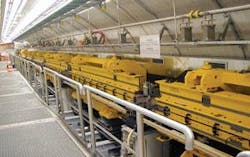Free-Electron Lasers: VUV free-electron laser in operation at DESY
Coherent radiation in the vacuum ultraviolet (VUV) and in the x-ray region will open the gate to exciting applications in fundamental research such as structural analysis of biological molecules, the study of light-matter interactions at extreme intensities, and applications in microscopy, holography, and semiconductor technology. Taking an important step toward wider use of coherent VUV light, the Deutsches Elektronen-Synchrotron (DESY; Hamburg, Germany) opened the first VUV free-electron laser (VUV-FEL) for user operation. The laser will provide radiation in the range of 6 to 100 nm, with ultrafast pulse durations of 20 to 200 fs and peak powers that can surpass by seven orders of magnitude the peak powers obtainable in current synchrotrons.
Programs to realize x-ray FELs down to a wavelength as low as 0.1 nm are under way at the Stanford Linear Accelerator Center (SLAC) and at DESY, both using linear accelerators as the electron guns. In comparison to synchrotron-radiation storage rings, linear accelerators generate and transport electron beams of higher “quality” (higher phase-space density), which means smaller beam diameters and opening angles and shorter electron bunches with higher peak currents. This advance in technology is necessary for generating laser-like VUV radiation and x-rays.
In the DESY VUV-FEL, a 260-m-long linear accelerator equipped with superconducting niobium cavities accelerates electrons to energies of up to 1 GeV, which then pass through a 30-m magnetic undulator. The electron bunches are formed in bunch trains containing up to 7200 bunches with a 9-MHz repetition rate and a bunch-train repetition rate of up to 10 Hz. First lasing was achieved earlier this year at 32 nm with a pulse length of about 20 fs.1
The formation of the laser-like VUV radiation is provided by self-amplified spontaneous emission (SASE). When the electrons interact with the electromagnetic field that they generate, the radiation field “imprints” its periodicity into the electron bunch, which splits into microbunches that are separated from each other by radiation wavelength. Depending on phase, the electrons become partly delayed or promoted, forming high-density microbunches that radiate synchronously in phase. Amplification builds up exponentially to saturation along the trajectory.
Linearly polarized radiation is emitted in the forward direction with a small angular divergence of 140 µrad, full width at half maximum (FWHM), and a FWHM bandwidth ∆λ/λ of about 0.5%. While the transverse coherence obtained is very high, the FEL pulse contains several longitudinal modes each of which is fully coherent and originates from a different part of the electron bunch.2, 3 This is characteristic of the SASE process, which builds from shot noise. The outstanding quality of advanced FEL radiation is best described when the brightness of the beam is calculated. It quantifies the number of photons emitted per second, per solid angle and area at the output of the radiation source for all photons with energies within ∆λ/λ = 0.1. For the VUV-FEL photon beam, the peak brilliance is on the order of 1028 photons/(s·mm2·mrad2·0.1% bandwidth), which is about seven orders of magnitude higher than current state-of-the-art synchrotron radiation sources.
At the VUV-FEL, experience will be gained for a future device called XFEL, to be built in Hamburg and completed in 2013; this FEL is intended to reach 0.085 nm, using a 20-GeV linear accelerator of 2.1-km length with up to 250‑m-long undulators.
REFERENCES
1. V. Ayvazyan, accepted for publication in EPJ D.
2. For example, see www.hasylab.desy.de/facility/fel/overview/basucs.htm and references therein.
3. E. Plönjes et al., Physics World, July 2003, p. 33.
About the Author
Uwe Brinkmann
Contributing Editor, Germany
Uwe Brinkmann was Contributing Editor, Germany, for Laser Focus World.
